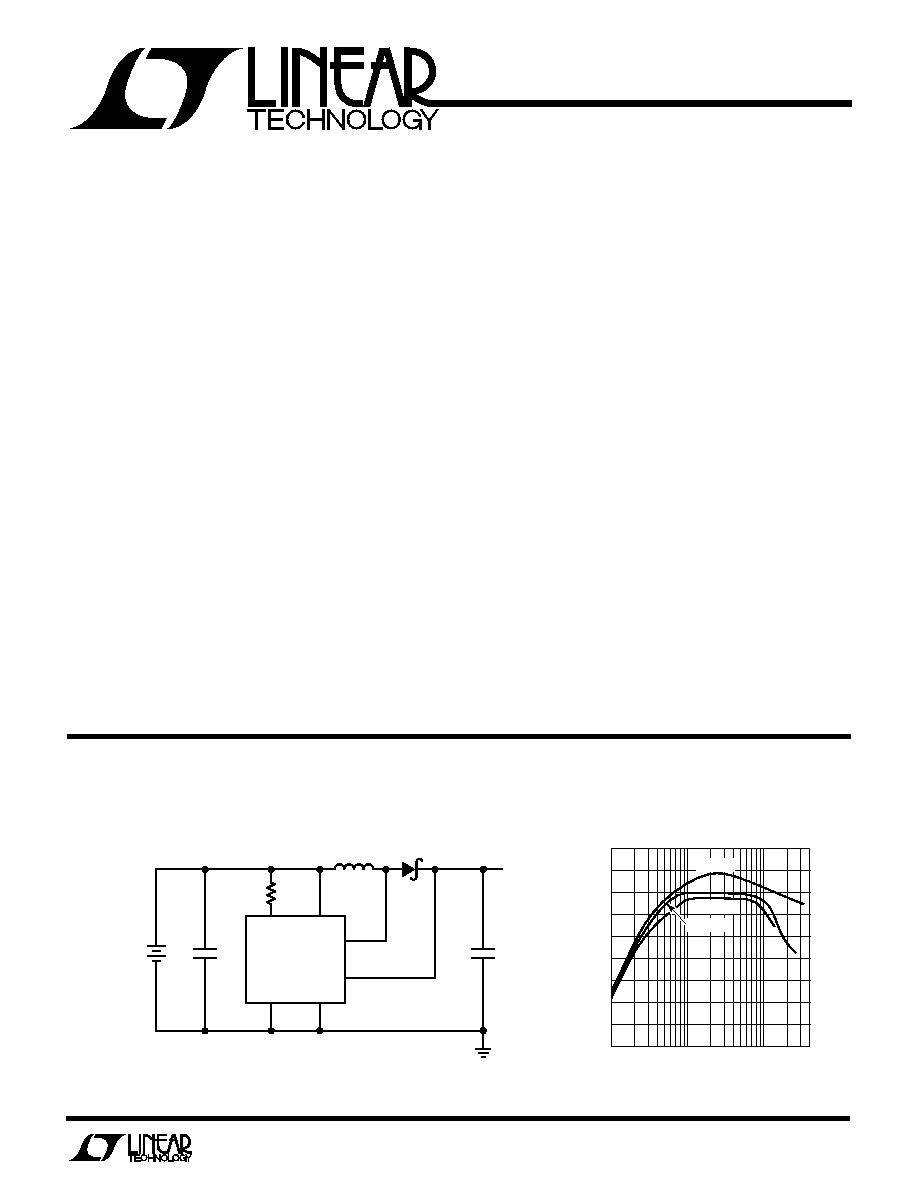
1
LT1107
Micropower
DC/DC Converter
Adjustable and Fixed 5V, 12V
U
A
O
PPLICATI
TYPICAL
Efficiency
D
U
ESCRIPTIO
S
FEATURE
s
Operates at Supply Voltages from 2V to 30V
s
Consumes Only 320
µ
A Supply Current
s
Works in Step-Up or Step-Down Mode
s
Only Three External Components Required
s
Low-Battery Detector Comparator On-Chip
s
User Adjustable Current Limit
s
Internal 1A Power Switch
s
Fixed or Adjustable Output Voltage Versions
s
Space Saving 8-Pin MiniDIP or SO-8 Package
The LT1107 is a versatile micropower DC/DC converter.
The device requires only three external components to
deliver a fixed output of 5V or 12V. Supply voltage ranges
from 2V to 12V in step-up mode and to 30V in step-down
mode. The LT1107 functions equally well in step-up, step-
down, or inverting applications.
The LT1107 is pin-for-pin compatible with the LT1111, but
has a duty cycle of 70%, resulting in increased output
current in many applications. The LT1107 can deliver
150mA at 5V from a 2AA cell input and 5V at 300mA from
24V in step-down mode. Quiescent current is just 320
µ
A,
making the LT1107 ideal for power-conscious battery-
operated systems. The 63kHz oscillator is optimized to
work with surface mount inductors and capacitors.
Switch current limit can be programmed with a single
resistor. An auxiliary gain block can be configured as a
low-battery detector, linear post regulator, undervoltage
lock-out circuit, or error amplifier.
U
S
A
O
PPLICATI
s
Palmtop Computers
s
3V to 5V, 5V to 12V Converters
s
24V to 5V, 12V to 5V Converters
s
LCD Bias Generators
s
Peripherals and Add-On Cards
s
Battery Backup Supplies
s
Cellular Telephones
s
Portable Instruments
LOAD CURRENT (mA)
1
EFFICIENCY (%)
82
80
78
76
74
72
70
68
66
64
10
100
400
1107 TA02
V
IN
= 3V
V
IN
= 2.5V
V
IN
= 2V
+
5V
150mA
+
MBRS120T3
L1*
33
µ
H
47
2
◊
AA
ALKALINE CELLS
100
µ
F
SUMIDA CD54-330K
COILCRAFT DT3316-473
*
I
LIM
V
IN
SENSE
SW1
SW2
GND
47
µ
F
LT1107-5
1107 TA01
Palmtop Computer Logic Supply
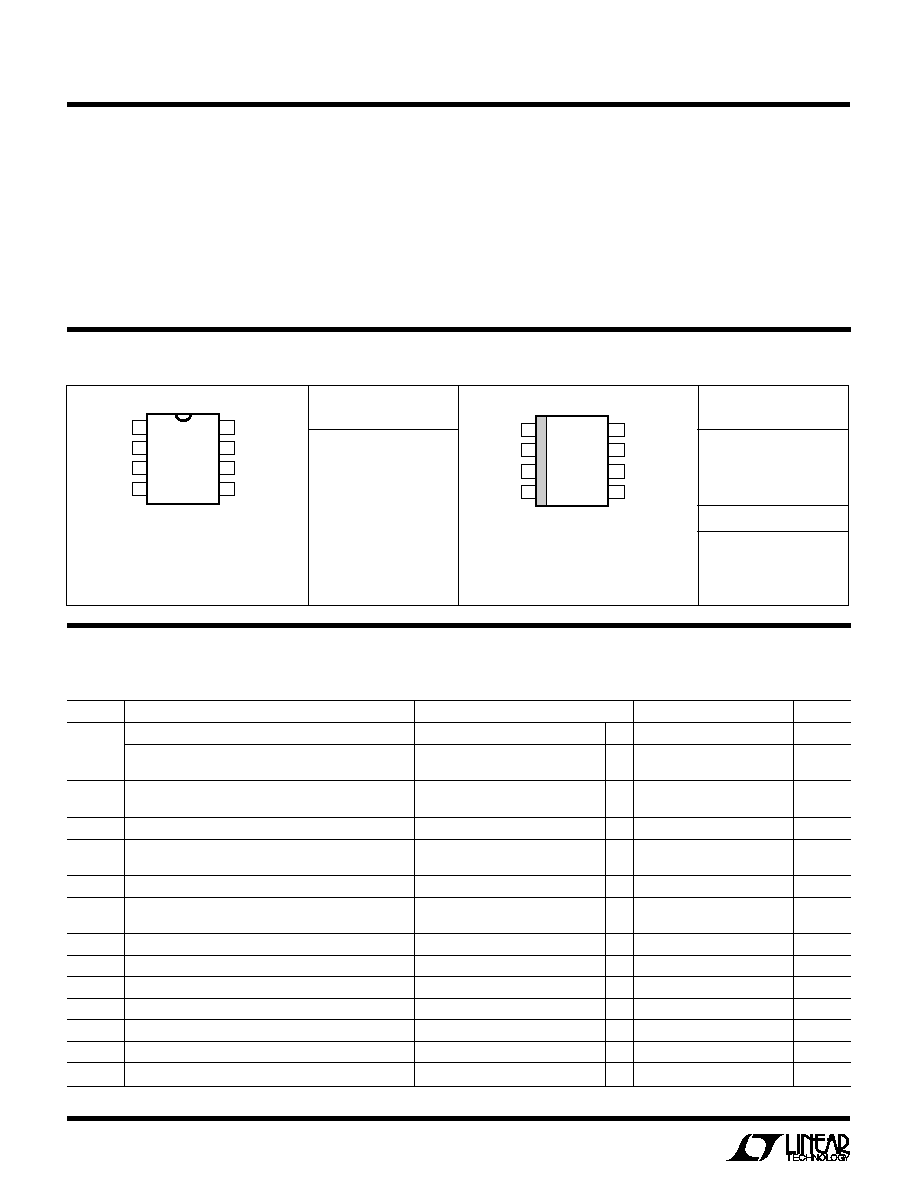
2
LT1107
A
U
G
W
A
W
U
W
A
R
BSOLUTE
XI
TI
S
Supply Voltage (V
IN
) ............................................... 36V
SW1 Pin Voltage (V
SW1
) ......................................... 50V
SW2 Pin Voltage (V
SW2
) ............................ ≠ 0.5V to V
IN
Feedback Pin Voltage (LT1107) ................................ 5V
Sense Pin Voltage (LT1107-5, LT1107-12) ............ 36V
Maximum Power Dissipation ............................ 500mW
Set Pin Voltage ...................................................... 5.5V
Maximum Switch Current ...................................... 1.5A
Operating Temperature Range
LT1107C ................................................ 0
∞
C to 70
∞
C
LT1107M ........................................ ≠ 55
∞
C to 125
∞
C
Storage Temperature Range ................. ≠ 65
∞
C to 150
∞
C
Lead Temperature (Soldering, 10 sec) .................. 300
∞
C
ELECTRICAL C
C
HARA TERISTICS
V
IN
= 3V, military or commercial version, T
A
= 25
∞
C, unless otherwise noted.
SYMBOL
PARAMETER
CONDITIONS
MIN
TYP
MAX
UNITS
I
Q
Quiescent Current
Switch OFF
320
450
µ
A
Quiescent Current, Step-Up Mode Configuration
No Load
LT1107-5
360
µ
A
LT1107-12
550
µ
A
V
IN
Input Voltage
Step-Up Mode
q
2
12.6
V
Step-Down Mode
q
30.0
V
Comparator Trip Point Voltage
LT1107 (Note 1)
q
1.2
1.25
1.3
V
V
OUT
Output Sense Voltage
LT1107-5 (Note 2)
q
4.75
5
5.25
V
LT1107-12 (Note 2)
q
11.40
12
12.60
V
Comparator Hysteresis
LT1107
q
8
12.5
mV
Output Hysteresis
LT1107-5
q
32
50
mV
LT1107-12
q
75
120
mV
f
OSC
Oscillator Frequency
50
63
77
kHz
Duty Cycle, Step-Up Mode
Full Load
64
70
76
%
t
ON
Switch ON Time, Step-Up Mode
I
LIM
Tied to V
IN
8.8
11
12.7
µ
s
Feedback Pin Bias Current
LT1107, V
FB
= 0V
q
70
120
nA
Set Pin Bias Current
V
SET
= V
REF
q
70
300
nA
V
OL
Gain Block Output Low
I
SINK
= 300
µ
A, V
SET
= 1V
q
0.15
0.4
V
Reference Line Regulation
5V
V
IN
30V
q
0.02
0.075
%/V
W
U
U
PACKAGE/ORDER I FOR ATIO
ORDER PART
NUMBER
ORDER PART
NUMBER
LT1107CN8
LT1107CN8-5
LT1107CN8-12
LT1107MJ8
LT1107MJ8-5
LT1107MJ8-12
LT1107CS8
LT1107CS8-5
LT1107CS8-12
T
JMAX
= 150
∞
C,
JA
= 120
∞
C/W (J)
T
JMAX
= 90
∞
C,
JA
= 130
∞
C/W (N)
T
JMAX
= 90
∞
C,
JA
= 150
∞
C/W
1107
11075
110712
S8 PART MARKING
1
2
3
4
8
7
6
5
TOP VIEW
I
LIM
V
IN
SW1
SW2
FB (SENSE)*
SET
AO
GND
J8 PACKAGE
8-LEAD CERAMIC DIP
N8 PACKAGE
8-LEAD PLASTIC DIP
* FIXED VERSIONS
1
2
3
4
8
7
6
5
TOP VIEW
S8 PACKAGE
8-LEAD PLASTIC SO
*FIXED VERSIONS
I
LIM
V
IN
SW1
SW2
FB(SENSE)*
SET
AO
GND

3
LT1107
ELECTRICAL C
C
HARA TERISTICS
V
IN
= 3V, military or commercial version, T
A
= 25
∞
C, unless otherwise noted.
SYMBOL
PARAMETER
CONDITIONS
MIN
TYP
MAX
UNITS
A
V
Gain Block Gain
R
L
= 100k (Note 3)
q
1000
6000
V/V
Current Limit
220
to I
LIM
to V
IN
400
mA
Current Limit Temperature Coefficient
q
≠ 0.3
%/
∞
C
Switch OFF Leakage Current
Measured at SW1 Pin, V
SW1
= 12V
1
10
µ
A
V
SW2
Maximum Excursion Below GND
I
SW1
10
µ
A, Switch OFF
≠ 400
≠ 350
mV
V
IN
= 3V, ≠ 55
∞
C
T
A
125
∞
C, unless otherwise noted.
LT1107C
SYMBOL
PARAMETER
CONDITIONS
MIN
TYP
MAX
UNITS
I
Q
Quiescent Current
Switch OFF
q
450
µ
A
f
OSC
Oscillator Frequency
q
50
63
88
kHz
DC
Duty Cycle
Step-Up Mode
q
62
69
78
%
Step-Down Mode, V
IN
= 12V
q
50
60
70
%
t
ON
Switch ON Time
Step-Up Mode
q
8
11
13.5
µ
s
Step-Down Mode, V
IN
= 12V
q
6
9
12.0
µ
s
Reference Line Regulation
2V
V
IN
5V
q
0.2
0.7
%/V
V
SAT
Switch Saturation Voltage, Step-Up Mode
V
IN
= 3V, I
SW
= 650mA
q
0.5
0.65
V
Switch Saturation Voltage, Step-Down Mode
V
IN
= 12V, I
SW
= 650mA
q
1.1
1.5
V
LT1107M
SYMBOL
PARAMETER
CONDITIONS
MIN
TYP
MAX
UNITS
I
Q
Quiescent Current
Switch OFF
q
500
µ
A
f
OSC
Oscillator Frequency
q
40
63
95
kHz
DC
Duty Cycle
Step-Up Mode
q
56
69
81
%
Step-Down Mode, V
IN
= 12V
q
45
60
73
%
t
ON
Switch ON Time
Step-Up Mode
q
7
11
15
µ
s
Step-Down Mode, V
IN
= 12V
q
5
9
13
µ
s
Reference Line Regulation
2V
V
IN
5V, 0
∞
C
T
A
125
∞
C
0.2
0.4
%/V
2.4V
V
IN
5V, T
A
= ≠ 55
∞
C
0.8
%/V
V
SAT
Switch Saturation Voltage, Step-Up Mode
0
∞
C
T
A
125
∞
C, I
SW
= 500mA
0.5
0.65
V
T
A
= ≠ 55
∞
C, I
SW
= 400mA
0.5
0.65
V
Switch Saturation Voltage, Step-Down Mode
V
IN
= 12V, I
SW
= 500mA
0
∞
C
T
A
125
∞
C
1.5
V
T
A
= ≠ 55
∞
C
2.0
V
V
IN
= 3V, 0
∞
C
T
A
70
∞
C, unless otherwise noted.
The
q
denotes specifications which apply over the full operating
temperature range.
Note 1: This specification guarantees that both the high and low trip points
of the comparator fall within the 1.2V to 1.3V range.
Note 2: The output voltage waveform will exhibit a sawtooth shape due to
the comparator hysteresis. The output voltage on the fixed-output versions
will always be within the specified range.
Note 3: 100k resistor connected between a 5V source and the AO pin.
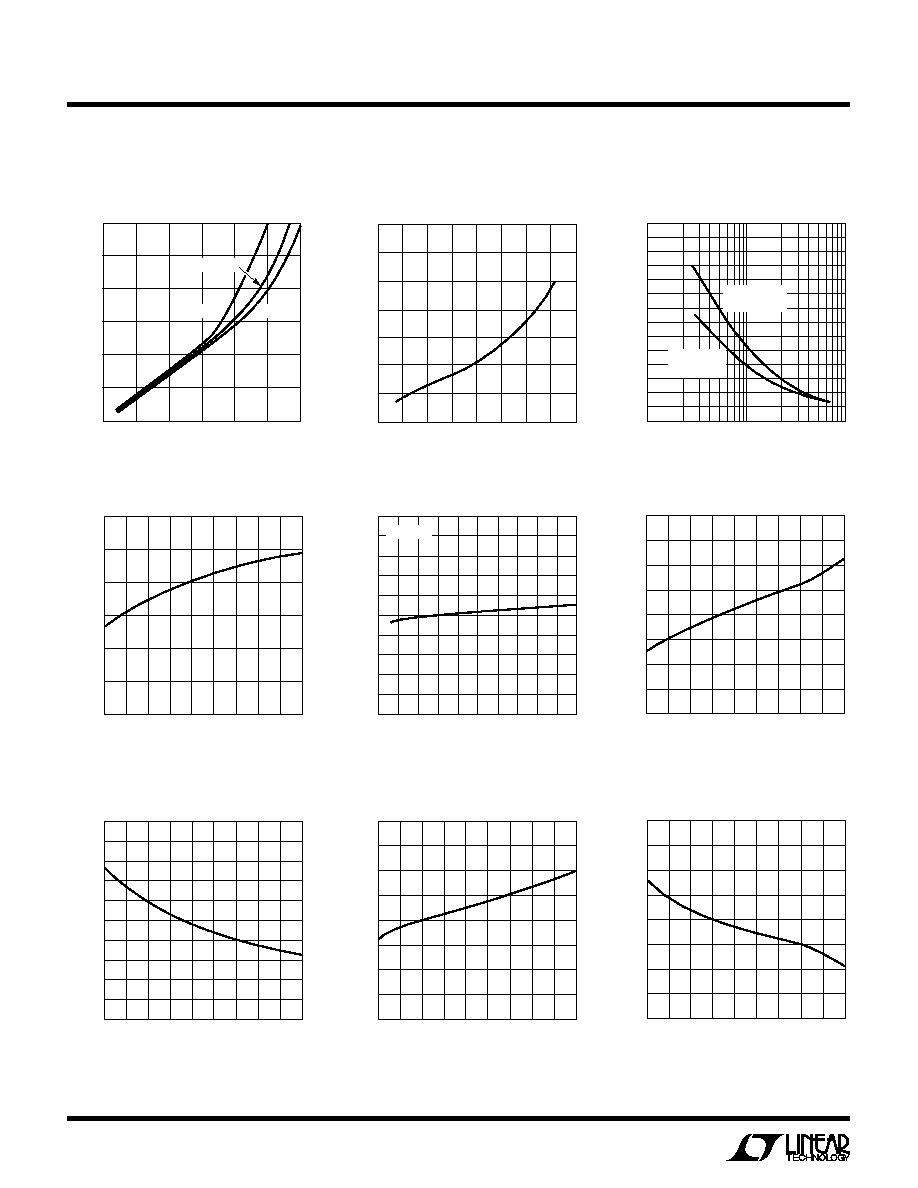
4
LT1107
C
C
HARA TERISTICS
U
W
A
TYPICAL PERFOR
CE
Saturation Voltage, Step-Up Mode
Switch ON Voltage, Step-Down
(SW2 Pin Grounded)
Mode (SW1 Pin Connected to V
IN
)
Maximum Switch Current vs R
LIM
Quiescent Current
Quiescent Current
TEMPERATURE (∞C)
≠55
FREQUENCY (kHz)
≠15
25
45
125
1107 G07
≠35
5
65
85 105
100
90
80
70
60
50
40
30
20
Oscillator Frequency
Switch ON Time
Step-Down Mode
TEMPERATURE (∞C)
≠55
SWITCH ON TIME (
µ
s)
≠15
25
45
125
1107 G10
≠35
5
65
85 105
13
12
11
10
9
8
7
6
5
TEMPERATURE (∞C)
≠55
DUTY CYCLE (%)
≠15
25
45
125
1107 G09
≠35
5
65
85 105
85
80
75
70
65
60
55
50
45
Duty Cycle
Step-Up Mode
TEMPERATURE (∞C)
≠55
QUIESCENT CURRENT (
µ
A)
≠15
25
45
125
1107 G05
≠35
5
65
85 105
400
350
300
250
200
150
100
TEMPERATURE (∞C)
≠55
SWITCH ON TIME (
µ
s)
≠15
25
45
125
1107 G08
≠35
5
65
85 105
16
15
14
13
12
11
10
9
8
7
6
Switch ON Time
Step-Up Mode
INPUT VOLTAGE (V)
0
QUIESCENT CURRENT (
µ
A)
400
380
360
340
320
300
280
260
240
220
200
24
1107 G06
6
12
18
30
3
9
15
21
27
T
A
= 25∞C
R
LIM
(
)
SWITCH CURRENT (A)
10
1107 G03
100
1.5
1.4
1.3
1.2
1.1
0.9
0.8
1000
0.7
0.6
0.5
0.4
0.3
0.2
0.1
1.0
STEP-DOWN
V
IN
= 12V
STEP-UP
2V
V
IN
5V
SWITCH CURRENT (A)
0
SWITCH ON VOLTAGE (V)
0.6
1107 G02
0.2
0.4
0.8
1.4
1.3
1.2
1.1
1.0
0.9
0.8
0.7
0.1
0.3
0.5
0.7
SWITCH CURRENT (A)
0
SATURATION VOLTAGE (V)
1.2
1.0
0.8
0.6
0.4
0.2
0
0.2
0.4
0.6
0.8
1107 G01
1.0
1.2
V
IN
= 3V
V
IN
= 2V
V
IN
= 5V

5
LT1107
I
LIM
(Pin 1): Connect this pin to V
IN
for normal use. Where
lower current limit is desired, connect a resistor between
I
LIM
and V
IN
. A 220
resistor will limit the switch current
to approximately 400mA.
V
IN
(Pin 2): Input Supply Voltage.
SW1 (Pin 3):
Collector of Power Transistor. For step-up
mode connect to inductor/diode. For step-down mode
connect to V
IN
.
SW2 (Pin 4):
Emitter of Power Transistor. For step-up
mode connect to ground. For step-down mode connect to
inductor/diode. This pin must never be allowed to go more
than a Schottky diode drop below ground.
GND (Pin 5): Ground.
AO (Pin 6): Auxiliary Gain Block (GB) Output. Open collector,
can sink 300
µ
A.
SET (Pin 7): GB Input. GB is an op amp with positive input
connected to SET pin and negative input connected to
1.25V reference.
FB/SENSE (Pin 8): On the LT1107 (adjustable), this pin
goes to the comparator input. On the LT1107-5 and
LT1107-12, this pin goes to the internal application resistor
that sets output voltage.
PI
U
FU
U
C
U
S
O
TI
C
C
HARA TERISTICS
U
W
A
TYPICAL PERFOR
CE
Minimum/Maximum Frequency
Minimum/Maximum Frequency
Duty Cycle
vs ON Time, Step-Down Mode
vs ON Time, Step-Up Mode
Step-Down Mode
TEMPERATURE (∞C)
≠55
DUTY CYCLE (%)
≠15
25
45
125
1107 G13
≠35
5
65
85 105
70
65
60
55
50
45
40
35
TEMPERATURE (∞C)
≠55
OUTPUT VOLTAGE (V)
≠15
25
45
125
1107 G16
≠35
5
65
85 105
5.3
5.2
5.1
5.0
4.9
4.8
4.7
TEMPERATURE (∞C)
≠55
OUTPUT VOLTAGE (V)
≠15
25
45
125
1107 G17
≠35
5
65
85 105
12.20
12.15
12.10
12.05
12.00
11.95
11.90
11.85
11.80
LT1107-5
LT1107-12
LT1107
Output Voltage
Output Voltage
Feedback Voltage
TEMPERATURE (∞C)
≠55
TRIP POINT VOLTAGE (V)
≠15
25
45
125
1107 G18
≠35
5
65
85 105
1.30
1.29
1.28
1.27
1.26
1.25
1.24
1.23
1.22
1.21
1.20
ON TIME (
µ
s)
4
FREQUENCY (kHz)
100
90
80
70
60
50
40
30
5
9
11
1107 G11
8
13 14
6
7
10
12
≠55
∞
C
T
A
125
∞
C
0
∞
C
T
A
70
∞
C
ON TIME (
µ
s)
6
FREQUENCY (kHz)
100
90
80
70
60
50
40
30
7
11
13
1107 G12
10
15 16
8
9
12
14
≠55
∞
C
T
A
125
∞
C
0
∞
C
T
A
70
∞
C
T
A
= 25
∞
C

6
LT1107
W
I
D AGRA
BLOCK
S
OPERATIO
U
The LT1107 is a gated oscillator switcher. This type
architecture has very low supply current because the
switch is cycled when the feedback pin voltage drops
below the reference voltage. Circuit operation can best be
understood by referring to the LT1107 block diagram.
Comparator A1 compares the feedback (FB) pin voltage
with the 1.25V reference signal. When FB drops below
1.25V, A1 switches on the 63kHz oscillator. The driver
amplifier boosts the signal level to drive the output NPN
power switch. The switch cycling action raises the output
voltage and FB pin voltage. When the FB voltage is suffi-
cient to trip A1, the oscillator is gated off. A small amount
of hysteresis built into A1 ensures loop stability without
external frequency compensation. When the comparator
output is low, the oscillator and all high current circuitry is
turned off, lowering device quiescent current to just 300
µ
A.
The oscillator is set internally for 11
µ
s ON time and 5
µ
s
OFF time in step-up mode, optimizing the device for
converters where V
OUT
3V
IN
. The combination of high
duty cycle and the current limit feature enables continuous
mode operation in many applications, increasing available
output power.
OSCILLATOR
1.25V
REFERENCE
V
IN
GND
SENSE
COMPARATOR
A2
A1
DRIVER
I
LIM
SW1
SW2
AO
GAIN BLOCK/
ERROR AMP
SET
1107 BD02
R1
R2
220k
LT1107-5: R1 = 73.5k
LT1107-12: R1 = 25.5k
OSCILLATOR
1.25V
REFERENCE
V
IN
GND
FB
COMPARATOR
A2
A1
DRIVER
I
LIM
SW1
SW2
AO
GAIN BLOCK/
ERROR AMP
SET
1107 BD01
LT1107
LT1107-5/LT1107-12
Gain block A2 can serve as a low-battery detector. The
negative input of A2 is the 1.25V reference. A resistor
divider from V
IN
to GND, with the mid-point connected to
the SET pin provides the trip voltage in a low-battery
detector application. AO can sink 300
µ
A (use a 22k
resistor pull-up to 5V).
A resistor connected between the I
LIM
pin and V
IN
sets
maximum switch current. When the switch current ex-
ceeds the set value, the switch cycle is prematurely
terminated. If current limit is not used, I
LIM
should be tied
directly to V
IN
. Propagation delay through the current limit
circuitry is approximately 1
µ
s.
In step-up mode the switch emitter (SW2) is connected to
ground and the switch collector (SW1) drives the induc-
tor; in step-down mode the collector is connected to V
IN
and the emitter drives the inductor.
The LT1107-5 and LT1107-12 are functionally identical to
the LT1107. The -5 and -12 versions have on-chip voltage
setting resistors for fixed 5V or 12V outputs. Pin 8 on the
fixed versions should be connected to the output. No
external resistors are needed.

7
LT1107
Inductor Selection ≠≠ Step-Up Converter
In a step-up, or boost converter (Figure 1), power gener-
ated by the inductor makes up the difference between
input and output. Power required from the inductor is
determined by:
where V
D
is the diode drop (0.5V for a 1N5818 Schottky).
Energy required by the inductor per cycle must be equal or
greater than:
in order for the converter to regulate the output.
When the switch is closed, current in the inductor builds
according to:
where R
is the sum of the switch equivalent resistance
(0.8
typical at 25
∞
C) and the inductor DC resistance.
When the drop across the switch is small compared to V
IN
,
the simple lossless equation:
As an example, suppose 12V at 60mA is to be generated
from a 3V to 6V input. Recalling equation (01),
Energy required from the inductor is:
Picking an inductor value of 33
µ
H with 0.2
DCR results
in a peak switch current of:
Substituting I
PEAK
into Equation 04 results in:
Since 11.9
µ
J > 9.05
µ
J, the 33
µ
H inductor will work. This
trial-and-error approach can be used to select the opti-
mum inductor.
A resistor can be added in series with the I
LIM
pin to invoke
switch current limit. The resistor should be picked so the
calculated I
PEAK
at minimum V
IN
is equal to the Maximum
Switch Current (from Typical Performance Characteristic
curves). Then, as V
IN
increases, peak switch current is
held constant, resulting in increasing efficiency.
Inductor Selection ≠≠ Step-Down Converter
The step-down case (Figure 2) differs from the step-up in
that the inductor current flows through the load during
both the charge and discharge periods of the inductor.
Current through the switch should be limited to ~650mA
in this mode. Higher current can be obtained by using an
external switch (see LT1111 and LT1110 data sheets). The
I
LIM
pin is the key to successful operation over varying
inputs.
After establishing output voltage, output current and input
voltage range, peak switch current can be calculated by the
formula:
U
S
A
O
PPLICATI
W
U
U
I FOR ATIO
P f
L
OSC
/
( )
02
I
t
V
R
e
L
IN
R t
L
( )
( )
=
-
-
1
03
I
t
V
L
t
L
IN
( )
=
( )
04
can be used. These equations assume that at t = 0,
inductor current is zero. This situation is called "discon-
tinuous mode operation" in switching regulator parlance.
Setting "t" to the switch ON time from the LT1107 speci-
fication table (typically 11
µ
s) will yield I
PEAK
for a specific
"L" and V
IN
. Once I
PEAK
is known, energy in the inductor
at the end of the switch ON time can be calculated as:
E
L
must be greater than P
L
/f
OSC
for the converter to deliver
the required power. For best efficiency I
PEAK
should be
kept to 1A or less. Higher switch currents will cause
excessive drop across the switch resulting in reduced
efficiency. In general, switch current should be held to as
low a value as possible in order to keep switch, diode and
inductor losses at a minimum.
P
f
mW
kHz
J
L
OSC
=
=
570
63
9 05
07
.
( )
µ
E
H
A
J
L
=
( )( )
=
1
2
33
0 85
11 91
09
2
µ
µ
.
.
( )
E
LI
L
PEAK
=
1
2
05
2
( )
P
V
V
V
mA
mW
L
=
+
-
(
)( )
=
12
0 5
3
60
570
06
.
( )
I
V
e
mA
PEAK
s
H
=
-
=
- ◊
3
1
1
850
08
1
11
33
µ
µ
( )
P
V
V
V
I
L
OUT
D
IN MIN
OUT
=
+
-
( )
( )
( )
01
I
I
DC
V
V
V
V
V
PEAK
OUT
OUT
D
IN
SW
D
=
+
-
+
2
10
( )

8
LT1107
In this mode the switch is arranged in common collector
or step-down mode. The switch drop can be modeled as
a 0.75V source in series with a 0.65
resistor. When the
switch closes, current in the inductor builds according to:
where R
= 0.65
+ DCR
L
V
L
= V
IN
≠ 0.75V
As an example, suppose ≠5V at 50mA is to be generated
from a 4.5V to 5.5V input. Recalling Equation (14),
Energy required from the inductor is:
Picking an inductor value of 100
µ
H with 0.2
DCR results
in a peak switch current of:
Substituting I
PEAK
into Equation (04) results in:
Since 5.28
µ
J > 3.82
µ
J, the 100
µ
H inductor will work.
With this relatively small input range, R
LIM
is not usually
necessary and the I
LIM
pin can be tied directly to V
IN
. As in
the step-down case, peak switch current should be limited
to ~650mA.
Step-Up (Boost Mode) Operation
A step-up DC/DC converter delivers an output voltage
higher than the input voltage. Step-up converters are
not
short-circuit protected since there is a DC path from input
to output.
P
f
mW
kHz
J
L
OSC
=
=
275
63
4 4
17
.
( )
µ
I
t
V
R
e
L
L
R t
L
( )
=
-
-
1
15
( )
where DC = duty cycle (0.50 in step-down mode)
V
SW
= switch drop in step-down mode
V
D
= diode drop (0.5V for a 1N5818)
I
OUT
= output current
V
OUT
= output voltage
V
IN
= minimum input voltage
V
SW
is actually a function of switch current which is in turn
a function of V
IN
, L, time, and V
OUT
. To simplify, 1.5V can
be used for V
SW
as a very conservative value.
Once I
PEAK
is known, inductor value can be derived from:
where t
ON
= switch ON time (7
µ
s).
Next, the current limit resistor R
LIM
is selected to give
I
PEAK
from the Maximum Switch Current vs R
LIM
curve.
The addition of this resistor keeps maximum switch cur-
rent constant as the input voltage is increased.
As an example, suppose 5V at 300mA is to be generated
from a 12V to 24V input. Recalling Equation (10):
Next, inductor value is calculated using Equation (11):
L
mA
s
H
=
-
-
=
12 1 5 5
600
7
64
13
.
( )
µ
µ
Use the next lowest standard value (56
µ
H).
Then pick R
LIM
from the curve. For I
PEAK
= 600mA, R
LIM
= 56
.
Inductor Selection ≠≠ Positive-to-Negative Converter
Figure 4 shows hookup for positive-to-negative conver-
sion. All of the output power must come from the inductor.
In this case,
P
(14)
L
=
+
(
)
( )
V
V
I
OUT
D
OUT
L
V
V
V
I
t
IN MIN
SW
OUT
PEAK
ON
=
-
-
◊
( )
( )
11
I
mA
mA
PEAK
=
(
)
+
-
+
=
2 300
0 50
5
0 5
12 1 5
0 5
600
12
.
.
.
.
( )
P
= 275mW
(16 )
L
= -
+
(
)
( )
5
0 5
50
V
V
mA
.
I
V
V
e
mA
PEAK
s
H
=
-
(
)
+
(
)
-
=
-
◊
4 5
0 75
0 65
0 2
1
325
18
0 85
9
100
.
.
.
.
( )
.
µ
µ
E
H
A
J
L
=
(
)(
)
=
1
2
100
0 325
5 28
19
2
µ
µ
.
.
( )
U
S
A
O
PPLICATI
W
U
U
I FOR ATIO
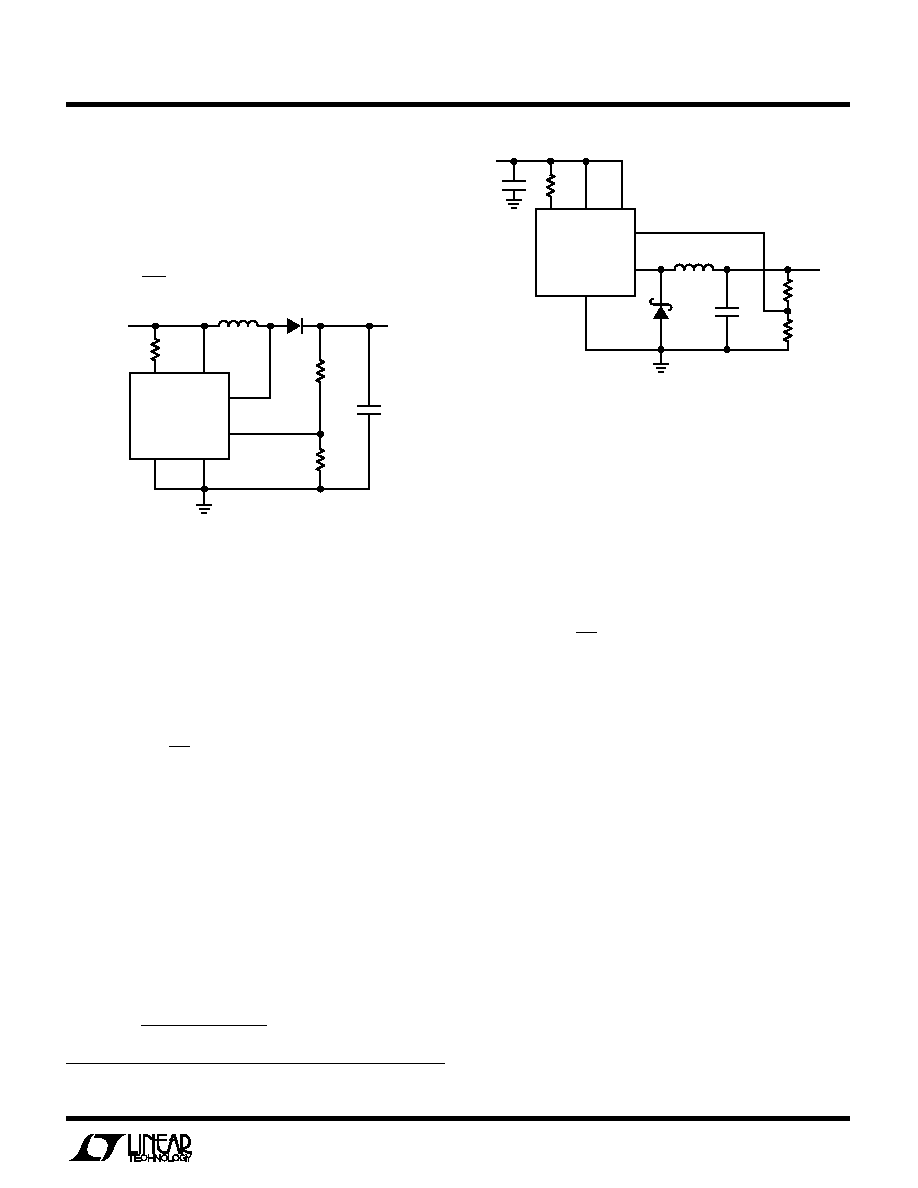
9
LT1107
U
S
A
O
PPLICATI
W
U
U
I FOR ATIO
I
V
L
t
PEAK
I N
ON
=
( )
20
The usual step-up configuration for the LT1107 is shown
in Figure 1. The LT1107 first pulls SW1 low causing V
IN
≠
V
CESAT
to appear across L1. A current then builds up in L1.
At the end of the switch ON time the current in L1 is
1
:
Figure 2. Step-Down Mode Hookup
+
D1
L1
R3
I
LIM
V
IN
FB
SW1
SW2
GND
C1
LT1107
1107 F01
V
IN
V
OUT
R2
R1
+
D1
1N5818
L1
R3
100
I
LIM
V
IN
FB
SW2
GND
C1
LT1107
1107 F02
V
IN
V
OUT
R2
R1
SW1
+
C2
Immediately after switch turn-off, the SW1 voltage pin
starts to rise because current cannot instantaneously stop
flowing in L1. When the voltage reaches V
OUT
+ V
D
, the
inductor current flows through D1 into C1, increasing
V
OUT
. This action is repeated as needed by the LT1107 to
keep V
FB
at the internal reference voltage of 1.25V. R1 and
R2 set the output voltage according to the formula:
Step-Down (Buck Mode) Operation
A step-down DC/DC converter converts a higher voltage to
a lower voltage. The usual hookup for an LT1107 based
step-down converter is shown in Figure 2.
When the switch turns on, SW2 pulls up to V
IN
≠ V
SW
. This
puts a voltage across L1 equal to V
IN
≠ V
SW
≠ V
OUT
,
causing a current to build up in L1. At the end of the switch
ON time, the current in L1 is equal to:
Figure 1. Step-Up Mode Hookup
V
R
R
V
OUT
= +
( )
1
2
1
1 25
21
.
( )
I
V
V
V
L
t
PEAK
I N
SW
OUT
ON
=
-
-
( )
22
When the switch turns off, the SW2 pin falls rapidly and
actually goes below ground. D1 turns on when SW2
reaches 0.4V below ground.
D1 MUST BE A SCHOTTKY
DIODE. The voltage at SW2 must never be allowed to go
below ≠0.5V. A silicon diode such as the 1N4933 will allow
SW2 to go to ≠0.8V, causing potentially destructive power
dissipation inside the LT1107. Output voltage is deter-
mined by:
R3 programs switch current limit. This is especially im-
portant in applications where the input varies over a wide
range. Without R3, the switch stays on for a fixed time
each cycle. Under certain conditions the current in L1 can
build up to excessive levels, exceeding the switch rating
and/or saturating the inductor. The 100
resistor pro-
grams the switch to turn off when the current reaches
approximately 700mA. When using the LT1107 in step-
down mode, output voltage should be limited to 6.2V or
less. Higher output voltages can be accommodated by
inserting a 1N5818 diode in series with the SW2 pin
(anode connected to SW2).
Inverting Configurations
The LT1107 can be configured as a positive-to-negative
converter (Figure 3), or a negative-to-positive converter
(Figure 4). In Figure 3, the arrangement is very similar to
a step-down, except that the high side of the feedback is
referred to ground. This level shifts the output negative. As
in the step-down mode, D1 must be a Schottky diode, and
V
R
R
V
OUT
= +
( )
1
2
1
1 25
23
.
( )
Note 1: This simple expression neglects the effects of switch and coil
resistance. This is taken into account in the "Inductor Selection" section.
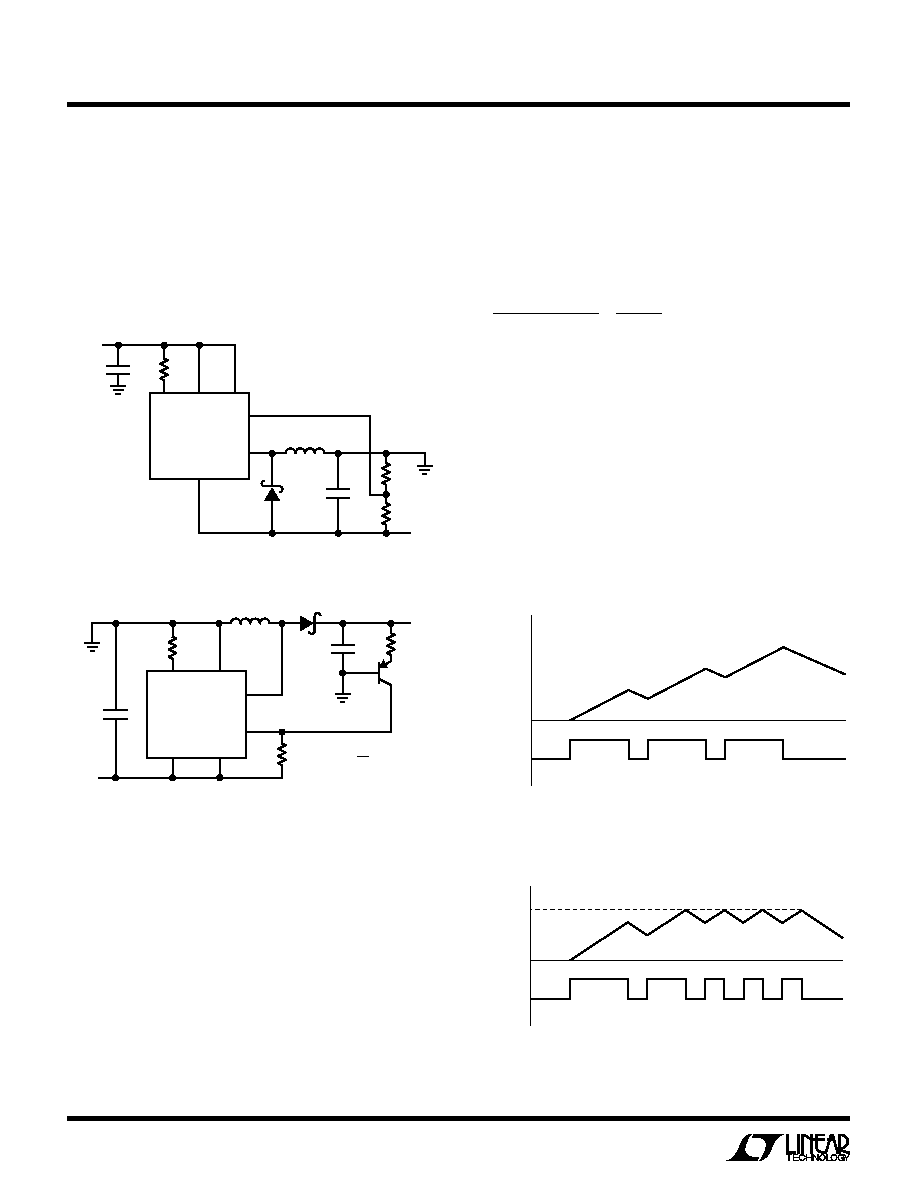
10
LT1107
V
OUT
should be less than 6.2V. More negative output
voltages can be accommodated as in the prior section.
In Figure 4, the input is negative while the output is
positive. In this configuration, the magnitude of the input
voltage can be higher or lower than the output voltage. A
level shift, provided by the PNP transistor, supplies proper
polarity feedback information to the regulator.
Figure 4. Negative-to-Positive Converter
Using the I
LIM
Pin
The LT1107 switch can be programmed to turn off at a set
switch current, a feature not found on competing devices.
This enables the input to vary over a wide range without
exceeding the maximum switch rating or saturating the
inductor. Consider the case where analysis shows the
LT1107 must operate at an 800mA peak switch current
with a 2V input. If V
IN
rises to 4V, the peak switch current
will rise to 1.6A, exceeding the maximum switch current
rating. With the proper resistor selected (see the "Maxi-
mum Switch
Current vs R
LIM
" characteristic), the switch
current will be limited to 800mA, even if the input voltage
increases.
Another situation where the I
LIM
feature is useful occurs
when the device goes into continuous mode operation.
This occurs in step-up mode when:
V
V
V
V
DC
OUT
DIODE
I N
SW
+
-
<
-
1
1
24
( )
When the input and output voltages satisfy this relation-
ship, inductor current does not go to zero during the
switch OFF time. When the switch turns on again, the
current ramp starts from the non-zero current level in the
inductor just prior to switch turn-on. As shown in Figure
5, the inductor current increases to a high level before the
comparator turns off the oscillator. This high current can
cause excessive output ripple and requires oversizing the
output capacitor and inductor. With the I
LIM
feature, the
switch turns off at the programmed current as shown in
Figure 6, keeping output ripple to a minimum.
Figure 6. Current Limit Keeps Inductor Current Under Control
Figure 5. No Current Limit Causes Large Inductor
Current Build-Up
1107 F05
I
OFF
L
ON
SWITCH
1107 F06
I
ON
L
OFF
SWITCH
PROGRAMMED CURRENT LIMIT
+
D1
L1
I
LIM
V
IN
FB
SW2
GND
C1
LT1107
1107 F04
+V
OUT
≠V
IN
R2
SW1
+
C2
2N3906
R1
V
OUT
= 1.25V + 0.6V
( )
R1
R2
R3
+
D1
1N5818
L1
R3
I
LIM
V
IN
FB
SW2
GND
C1
LT1107
1107 F03
+V
IN
≠V
OUT
R1
R2
SW1
+
C2
Figure 3. Positive-to-Negative Converter
U
S
A
O
PPLICATI
W
U
U
I FOR ATIO
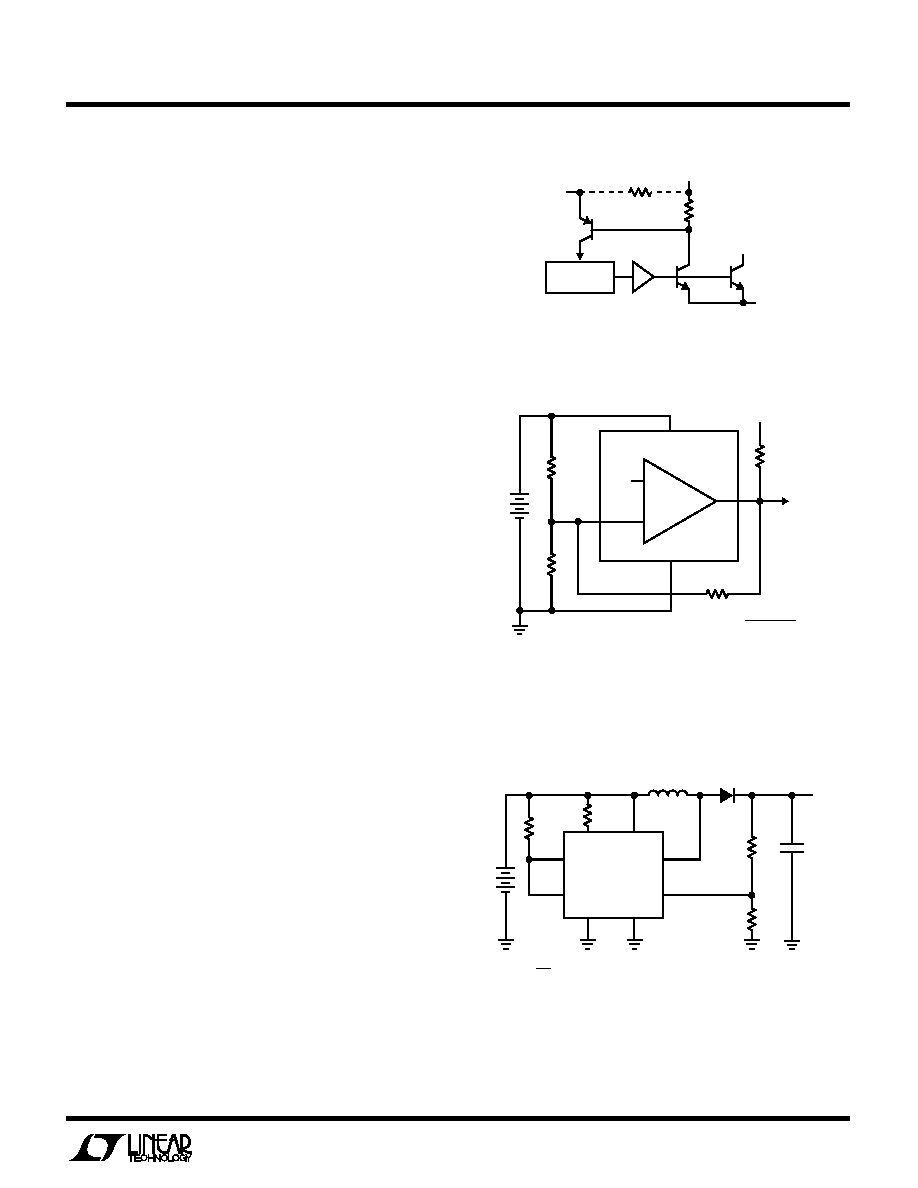
11
LT1107
Figure 7 details current limit circuitry. Sense transistor A1,
whose base and emitter are paralleled with power switch
Q2, is ratioed such that approximately 0.5% of Q2's
collector current flows in Q1's collector. This current is
passed through internal 80
resistor R1 and out through
the I
LIM
pin. The value of the external resistor connected
between I
LIM
and V
IN
sets the current limit. When suffi-
cient switch current flows to develop a V
BE
across R1 +
R
LIM
, Q3 turns on and injects current into the oscillator,
turning off the switch. Delay through this circuitry is
approximately 800ns. The current trip point becomes less
accurate for switch ON times less than 3
µ
s. Resistor
values programming switch ON time for 800ns or less will
cause spurious response in the switch circuitry although
the device will still maintain output regulation.
Using the Gain Block
The gain block (GB) on the LT1107 can be used as an error
amplifier, low-battery detector or linear post regulator.
The gain block itself is a very simple PNP input op amp with
an open collector NPN output. The negative input of the
gain block is tied internally to the 1.25V reference. The
positive input comes out on the SET pin.
Arrangement of the gain block as a low-battery detector is
straightforward. Figure 8 shows hookup. R1 and R2 need
only be low enough in value so that the bias current of the
SET input does not cause large errors. 33k for R2 is
adequate. R3 can be added to introduce a small amount of
hysteresis. This will cause the gain block to "snap" when
the trip point is reached. Values in the 1M to 10M range are
optimal. The addition of R3 will change the trip point,
however.
Output ripple of the LT1107, normally 50mV at 5V
OUT
can
be reduced significantly by placing the gain block in front
of the FB input as shown in Figure 9. This effectively
reduces the comparator hysteresis by the gain of the gain
block. Output ripple can be reduced to just a few millivolts
using this technique. Ripple reduction works with step-
down or inverting modes as well. For this technique to be
effective, output capacitor C1 must be large, so that each
switching cycle increases V
OUT
by only a few millivolts.
1000
µ
F is a good starting value. C1 should be a low ESR
type as well.
U
S
A
O
PPLICATI
W
U
U
I FOR ATIO
1107 F07
SW2
SW1
DRIVER
OSCILLATOR
V
IN
I
LIM
R1
80
(INTERNAL)
R
LIM
(EXTERNAL)
Q3
Q2
Q1
Figure 7. LT1107 Current Limit Circuitry
L1
1107 F09
D1
R3
270k
+
V
OUT
R2
R1
C1
V
BAT
LT1107
GND
SW2
SET
SW1
I
LIM
V
IN
FB
AO
V
OUT
= + 1 1.25V
R2
R1
( )( )
Figure 9. Output Ripple Reduction Using Gain Block
Figure 8. Setting Low-Battery Detector Trip Point
1107 F08
V
BAT
R1
R2
1.25V
REF
SET
GND
V
IN
LT1107
47k
5V
TO
PROCESSOR
AO
R3
R1 =
V
LB
= BATTERY TRIP POINT
R2 = 33k
R3 = 1.6M
(
)
V
LB
≠ 1.25V
35.1
µ
A
+
≠
Information furnished by Linear Technology Corporation is believed to be accurate and reliable.
However, no responsibility is assumed for its use. Linear Technology Corporation makes no represen-
tation that the interconnection of its circuits as described herein will not infringe on existing patent rights.
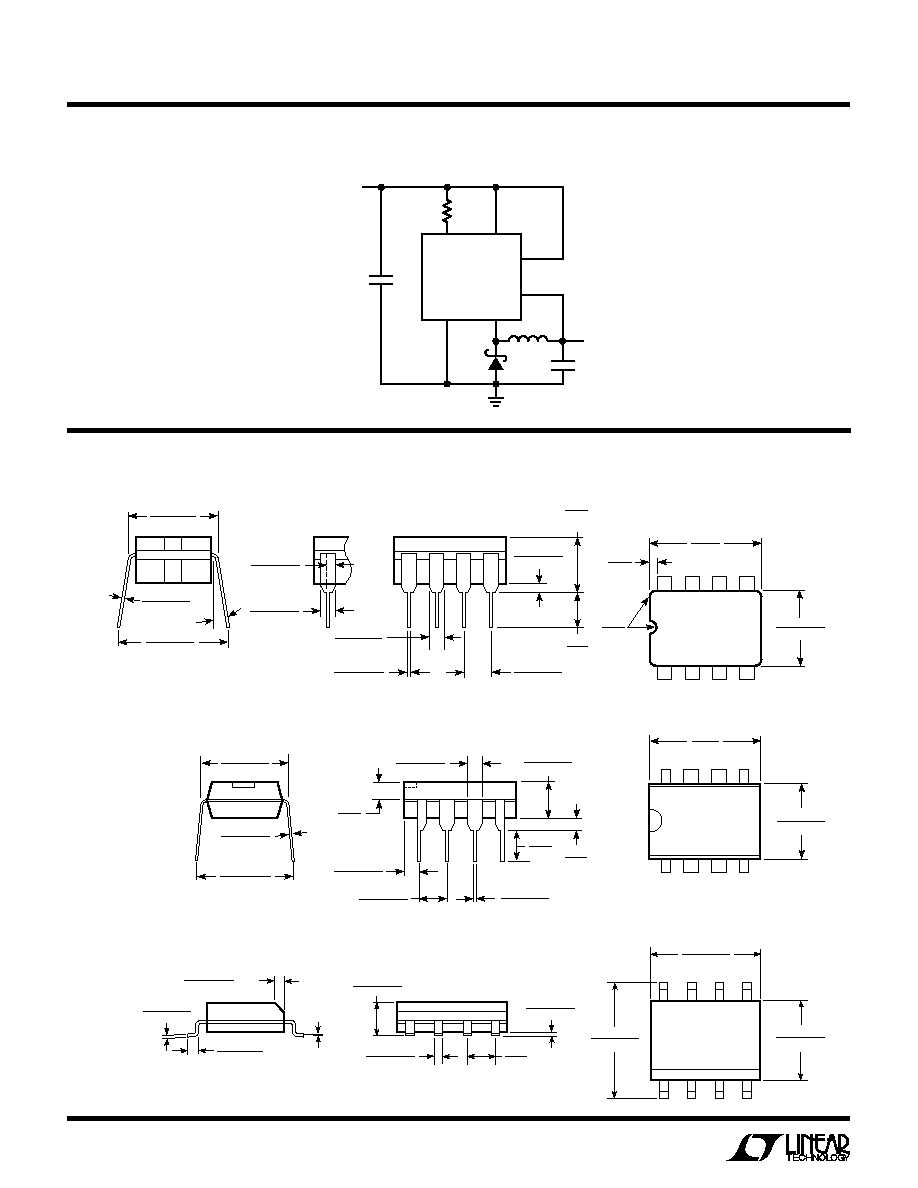
12
LT1107
Linear Technology Corporation
1630 McCarthy Blvd., Milpitas, CA 95035-7487
(408) 432-1900
q
FAX
: (408) 434-0507
q
TELEX
: 499-3977
©
LINEAR TECHNOLOGY CORPORATION 1993
LTC/GP 0993 10K REV 0 ∑ PRINTED IN USA
U
PACKAGE DESCRIPTIO
Dimensions in inches (millimeters) unless otherwise noted.
0.045 ± 0.015
(1.143 ± 0.381)
0.100 ± 0.010
(2.540 ± 0.254)
0.065
(1.651)
TYP
0.045 ≠ 0.065
(1.143 ≠ 1.651)
0.130 ± 0.005
(3.302 ± 0.127)
0.020
(0.508)
MIN
0.018 ± 0.003
(0.457 ± 0.076)
0.125
(3.175)
MIN
0.009 ≠ 0.015
(0.229 ≠ 0.381)
0.300 ≠ 0.320
(7.620 ≠ 8.128)
0.325
+0.025
≠0.015
+0.635
≠0.381
8.255
(
)
1
2
3
4
8
7
6
5
0.250 ± 0.010
(6.350 ± 0.254)
0.400
(10.160)
MAX
0.290 ≠ 0.320
(7.366 ≠ 8.128)
0.008 ≠ 0.018
(0.203 ≠ 0.457)
0∞ ≠ 15∞
0.385 ± 0.025
(9.779 ± 0.635)
0.005
(0.127)
MIN
0.405
(10.287)
MAX
0.220 ≠ 0.310
(5.588 ≠ 7.874)
1
2
3
4
8
7
6
5
0.025
(0.635)
RAD TYP
0.045 ≠ 0.068
(1.143 ≠ 1.727)
FULL LEAD
OPTION
0.023 ≠ 0.045
(0.584 ≠ 1.143)
HALF LEAD
OPTION
CORNER LEADS OPTION
(4 PLCS)
0.014 ≠ 0.026
(0.360 ≠ 0.660)
0.200
(5.080)
MAX
0.015 ≠ 0.060
(0.381 ≠ 1.524)
0.125
3.175
MIN
0.100 ± 0.010
(2.540 ± 0.254)
0.045 ≠ 0.068
(1.143 ≠ 1.727)
NOTE: LEAD DIMENSIONS APPLY TO
SOLDER DIP OR TIN PLATE LEADS.
1
2
3
4
0.150 ≠ 0.157
(3.810 ≠ 3.988)
8
7
6
5
0.189 ≠ 0.197
(4.801 ≠ 5.004)
0.228 ≠ 0.244
(5.791 ≠ 6.197)
0.016 ≠ 0.050
0.406 ≠ 1.270
0.010 ≠ 0.020
(0.254 ≠ 0.508)
◊
45
∞
0∞≠ 8∞ TYP
0.008 ≠ 0.010
(0.203 ≠ 0.254)
0.053 ≠ 0.069
(1.346 ≠ 1.752)
0.014 ≠ 0.019
(0.355 ≠ 0.483)
0.004 ≠ 0.010
(0.101 ≠ 0.254)
0.050
(1.270)
BSC
N8 Package, 8-Lead Plastic DIP
J8 Package, 8-Lead Ceramic DIP
S8 Package, 8-Lead Plastic SOIC
U
A
O
PPLICATI
TYPICAL
24V-to-5V Step-Down Converter
+
5V
300mA
1N5818
150
µ
H*
220
22
µ
F
*COILTRONICS CTX150-4
I
LIM
V
IN
SENSE
SW1
SW2
GND
24V
IN
LT1107-5
1107 TA03
+
330
µ
F











